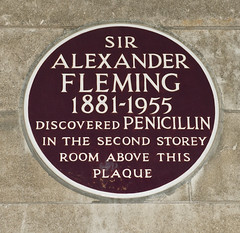penicillin
Commemorated on 4 plaques
Sir Alexander Fleming 1881-1955 discovered penicillin in the second storey room above this plaque
St Mary's Hospital, Praed Street, W2, London, United Kingdom where it was discovered (1928)
G. Raymond Rettew. A West Chester chemist, he pioneered the mass production of penicillin, the world's first antibiotic. In 1943, with Wyeth Laboratories, his lab ( a converted auto repair shop here) made & sent more penicillin to the Armed Forces than any other lab in the world, saving countless lives on the battlefields of World War II.
Walnut & Chestnut Streets, West Chester, PA, United States where it was manufactured
In this former Pharmacy Kenneth White made the first penicillin for civilian use during WW2 at these premises 1943-1951
Cellar Wines, The Old Cellar, High Street, Ripley, United Kingdom where it was manufactured (1943-1951)
Penicillin: The first antibiotic was first used to treat infection here at the Outpatients building of the former Radcliffe Infirmary on 12 February 1941. Nuffield Department of Primary Care Health Sciences University of Oxford.
Nuffield Department of Primary Care Health Sciences - Woodstock Road, Oxford, United Kingdom where it first used to treat infection here (1941)




